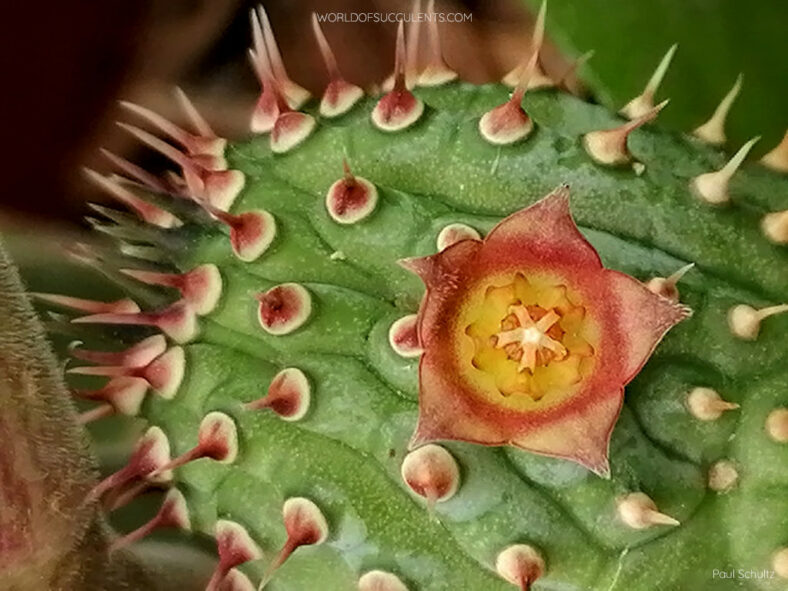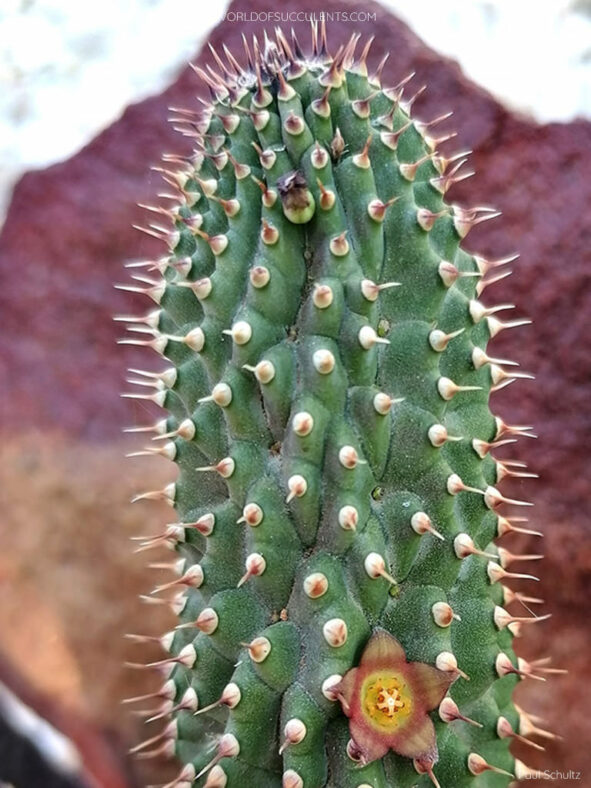Hoodia officinalis has a long history of use as a medicinal and food plant. It is said to be the sweetest-tasting of all Hoodias and is well-known in Namibia and South Africa.
Scientific Name
Hoodia officinalis (N.E.Br.) Plowes
Synonym(s)
Ceropegia officinalis, Trichocaulon officinale
Scientific Classification
Family: Apocynaceae
Subfamily: Asclepiadoideae
Tribe: Ceropegieae
Genus: Hoodia
Etymology
The specific epithet "officinalis" (pronounced oh-fiss-ih-NAH-liss) means "medicinal" and refers to the use of this species as a medicinal plant.
Origin
Hoodia officinalis is native to Namibia and South Africa. It grows inside bushes in flat or gently sloping areas.
Description
Hoodia officinalis is a succulent plant that forms a clump of gray-green to brown-green stems with tubercles joined in the lower half into 14 to 23 ribs. The cylindrical stems are either erect or sprawling and can grow up to 16 inches (40 cm) long and 2.8 inches (7 cm) in diameter. Each tubercle is tipped with a sharp brown spine measuring up to 0.5 inches (1.2 cm) long.
From spring to fall, Hoodia officinalis produces bell-shaped flowers that can reach a diameter of 0.8 inches (2 cm). The corolla ranges from pale green with brownish veins to reddish-brown on the outside, while the inside is red-brown to yellow-brown with a covering of small conical papillae, each tipped with a fine bristle. The tube is often much paler yellow. The corona is yellow to dark red-brown and raised on a very short stipe.
There are two recognized subspecies:
- Hoodia officinalis subsp. officinalis: This subspecies is found in southern Namibia and the Northern Cape province of South Africa. Its stems can grow up to 12 inches (30 cm) long and have a diameter of 2.6 inches (6.5 cm). The spines on the tubercles can measure up to 0.25 inches (0.6 cm) long, while the flowers have a diameter ranging from 0.4 to 0.55 inches (1 to 1.4 cm).
- Hoodia officinalis subsp. delaetiana: This subspecies is restricted to the Tsau ǁKhaeb (Sperrgebiet) National Park in southern Namibia. It is larger than the subsp. officinalis, with longer spines measuring up to 0.5 inches (1.2 cm) long and larger flowers that range from 0.55 to 0.8 inches (1.4 to 2 cm) in diameter.

How to Grow and Care for Hoodia officinalis
Light: Hoodia officinalis prefers full sun but benefits from light shade on the hottest summer days. Indoors, place the plant near the brightest window in your home, as it will stretch if it doesn't receive enough sunlight. Avoid abruptly moving a plant adapted to lower light levels to full sun to prevent sunburn.
Soil: Use a commercial potting soil mix designed for succulents or prepare your own with 50% to 70% mineral grit, such as coarse sand, pumice, or perlite.
Temperature: The plant thrives in warm outdoor environments with low to moderate humidity. It does not like winter cold and should remain fairly dry and warm during its dormancy. Hoodia officinalis grows best in USDA Plant Hardiness Zones 10a to 11b, with average minimum winter temperatures ranging from 30°F to 50°F (-1.1°C to 10°C).
Watering: It has typical watering needs for a succulent. During the growing season, from spring to fall, water the plant thoroughly and allow the soil to dry between waterings. When it goes dormant in winter, it needs almost no water, about once a month.
Fertilizing: Fertilizing is beneficial to keep the plant healthy and thriving. Feed it with water-soluble fertilizer diluted to half the recommended strength, but only when the plant is actively growing.
Repotting: Repot Hoodia officinalis in spring, just before the growing season. It has shallow roots and doesn't require a lot of soil to grow. Always pick a container with drainage holes.
Propagation: The best way to propagate this succulent is by stem cuttings. To ensure good rooting, take cuttings during the growing season. The plant is also easy to start from seeds in spring.
Learn more at How to Grow and Care for Stapeliads.
Toxicity of Hoodia officinalis
Hoodia officinalis is non-toxic and safe to grow around kids and pets.
Links
- Back to genus Hoodia
- Succupedia: Browse succulents by Scientific Name, Common Name, Genus, Family, USDA Hardiness Zone, Origin, or cacti by Genus
Photo Gallery
Click on a photo to see a larger version.


